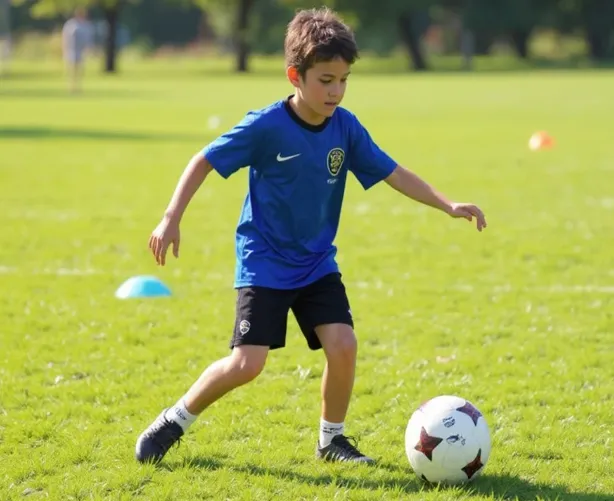Youth soccer is a crucial phase in a young athlete’s development, where the foundation for future success is laid. For 10-year-olds, soccer training is vital in refining essential skills, boosting tactical knowledge, and enhancing overall growth as players. At this age, players are not only building technical abilities but also cultivating a passion for the sport.
Understanding how children develop physically and mentally is essential for creating effective training programs. At 10 years old, children experience significant changes in coordination, strength, and balance, making it important for coaches to adapt their approach accordingly. Their cognitive abilities are also rapidly evolving, meaning they are keen to absorb new techniques and strategies. Coaches should focus on creating a positive, supportive environment that nurtures confidence and love for the game.
In this post, we’ll cover key soccer training drills that will help 10-year-olds enhance their skills and knowledge in five key areas of development.
1. Developing Core Skills
Building strong fundamental skills is crucial at this stage. Just as a house requires a strong foundation, young soccer players need to master basic techniques to succeed in more advanced aspects of the game later on. Mastering these foundational skills boosts players’ confidence and prepares them for greater challenges.
Dribbling Drills
Dribbling is a fundamental skill that allows players to control the ball and maneuver around opponents. Practice should focus on improving ball control and confidence with the ball at their feet.
Passing and Receiving
Passing and receiving accurately is essential for maintaining possession and facilitating teamwork. Training should emphasize passing accuracy, receiving with control, and effective communication with teammates.
Shooting Drills
Shooting drills aim to improve accuracy, power, and decision-making in front of the goal. Encouraging 10-year-olds to practice different types of shots will help develop their goal-scoring instincts.
2. Tactical Awareness
While technical skills are important, understanding the tactical side of soccer is what sets good players apart from great ones. Tactical awareness allows young players to read the game, make quick decisions, and position themselves effectively.
Small-Sided Games
Small-sided games (such as 3v3 or 4v4) promote decision-making in real-game situations. These games allow players to focus on positioning and teamwork while providing more opportunities to touch the ball.
Positional Drills
Positional play drills help players understand their roles on the field and how to create space and angles effectively. Knowing where to be and when is key for improving overall team dynamics.
Decision-Making Exercises
Soccer is fast-paced, and players must think quickly. Drills that challenge players to make smart decisions under pressure will improve their ability to adapt to different game situations.
3. Physical Conditioning
Physical conditioning is essential for youth players to perform at their best. Soccer demands speed, agility, and endurance, and starting conditioning at a young age helps build a strong foundation for long-term success.
Proper conditioning improves overall fitness, helping players run faster, recover quicker, and perform consistently throughout the game. It also enhances coordination, balance, and flexibility, which are necessary for executing soccer movements with precision.
Youth conditioning also helps develop discipline and work ethic—valuable traits both on and off the field. Coaches should incorporate age-appropriate conditioning drills to prepare players for the physical demands of the game.
4. Mental Preparation
At 10 years old, players are starting to understand the importance of mental preparation. Setting achievable goals helps young athletes stay focused and motivated. Coaches should guide players to set realistic yet challenging goals that promote growth and confidence.
Visualization Techniques
Visualization is a powerful tool for mental preparation. Encouraging players to mentally rehearse successful actions, such as dribbling past opponents or scoring goals, can strengthen neural pathways, improving muscle memory and performance.
5. Injury Prevention and Safety
Youth players are still in their physical development stages, so it’s crucial to ensure they train safely and avoid injury. Coaches should monitor training loads to ensure they are age-appropriate and avoid pushing players too hard. Proper equipment, such as well-fitted cleats and shin guards, plays a key role in injury prevention.
Hydration is also essential, especially since young athletes are more prone to heat-related issues. Encouraging regular water breaks and ensuring players stay hydrated throughout training and matches is vital.
Coaches and parents must also be vigilant about signs of overtraining, such as fatigue, decreased performance, or frequent injuries. Early intervention can prevent long-term issues and keep players on track for sustained growth.
Conclusion
Effective training for 10-year-olds is key to developing their soccer skills and fostering a love for the game. By focusing on foundational skills, tactical awareness, physical conditioning, mental preparation, and injury prevention, coaches can help young players unlock their potential. With the right mix of challenging drills and a supportive environment, young athletes will develop into skilled, confident players who can contribute to their team’s success and enjoy the journey of soccer.
















